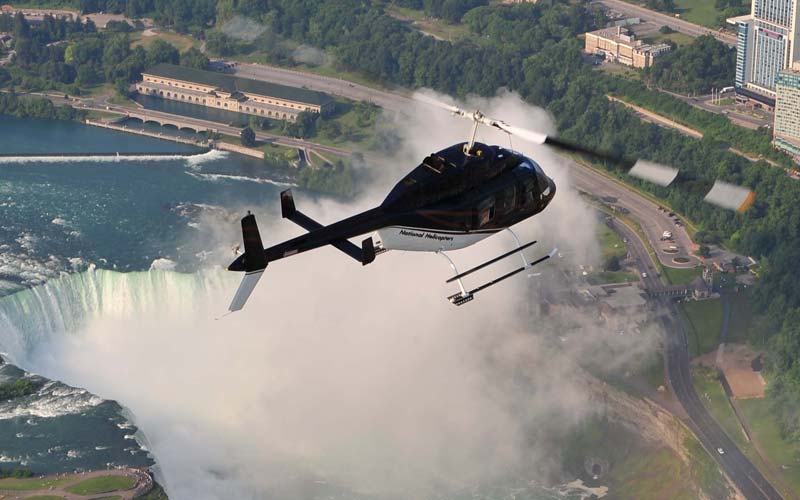Visiting Canada can be a unique and unforgettable experience that would heal your soul, open new horizons, and bring you closer to nature, whose children we are. This journey is an adventure that brings the whole family together, strengthening bonds by sharing memorable moments. With its rich cultural heritage, diverse range of activities throughout the year, and diverse biodiversity, Canada has numerous hidden gems.
It was not easy to choose just 12 places to visit in Canada. However, we have compiled a short list of the top hidden gems.
1. Niagara-on-the-Lake: Where history blooms and wine flows.
Once the first capital of Upper Canada, Niagara-on-the-Lake is a lakeside town where time seems to have stopped. Its Victorian-era architecture, colourful flowers filling the streets, and charming boutique shops make it a peaceful family retreat for its visitors. You can learn more about the city’s history, traditions, and unique features by riding a horse-drawn carriage through the lakeside streets.

Niagara has an ancient tradition of wineries. Families harvest grapes in their vineyards and produce wine in an artisanal way. Indeed, in every street and town garden, you will be amazed by the variety, vibrant colours, and intoxicating fragrance of the flowers.
A visit to this town wouldn’t be complete without experiencing its art and culture, which come to life each year from April to October through the Shaw Festival. This festival showcases world-class performances, blending the works of George Bernard Shaw with modern plays across its four venues. Book your Niagara-On-The-Lake & Niagara Falls tours with ToNiagara.
2. Churchill, Manitoba – in the heart of the Northern Lights.
Churchill, Manitoba, is a remote subarctic town located on the western shores of Hudson Bay. It is renowned as one of the best places in the world to clearly and closely experience the Aurora Borealis. Due to the town’s position, beneath the Auroral Oval from January to March, the Northern Lights put on an indescribable light show that fills the Arctic sky.

During Autumn, polar bears migrate from deep inland areas towards the coast, allowing visitors to get incredibly close to these giant creatures through the use of special tundra vehicles. It is amazing to see them in their natural habitat and to be so close to them. Churchill is known worldwide as the “Polar Bear Capital of the World.”
During the summer, thousands of Beluga whales swim in the Churchill River. You can join them by kayaking or taking a boat ride to get a close-up view of these amazing marine creatures and experience the wild world of mammals up close.
A visit to Churchill, Manitoba, is always a good choice at any time of the year.
3. Québec City – a touch of Europe in North America
Québec City was founded in 1608 by Samuel de Champlain. Tradition and modernity blend seamlessly in this small city with deep European historical roots and meticulously preserved architecture.

Due to its dignified representation of history and culture and its centuries-long preservation of these values, Québec City was designated a UNESCO World Heritage Site. Visiting the Old Québec district feels like stepping into a bygone era that proudly showcases its European heritage.
A true historical monument, the Château Frontenac Hotel was built in 1893 as part of a series of luxury hotels for the Canadian Pacific Railway. Today, the hotel attracts visitors from around the world with its timeless elegance and offers magical photo opportunities at every corner.
If you visit Québec City, you cannot miss a ride on the panoramic Train de Charlevoix. It will take 4.5 hours to travel from Québec City to La Malbaie, but every minute spent on that train will fill your heart with art painted by nature.
4. Nahanni National Park Reserve – An Adventure in the Wild, Untouched Nature.
To witness a pristine world untouched by human hands and experience nature’s beauty without filters, you must visit Nahanni National Park Reserve. This natural wonder, covering 30,000 square kilometres, is located in the Dehcho region near the Yukon border. While visiting Nahanni National Park Reserve, you will feel deeply connected to nature, a force that never ceases to amaze you.

It was one of the first destinations in the world to become a UNESCO World Heritage Site, thanks to its meticulous preservation of originality, which will be passed down through generations as a testament to our origins.
No roads have been built for vehicles to keep this slice of wilderness unchanged and untouched, so you must travel to the park by plane or paddle in by canoe. Like a bride dressed in a white veil, Virginia Falls stands twice the height of Niagara. It was discovered in 1928 by an American adventurer, who gave his daughter’s name to the fall.
Majestic and powerful, it crashes from above, carving hidden caves and deep canyons along its path.
Those passionate about aquatic adventures can explore the South Nahanni River. Hop in a kayak and embark on a multi-day journey that will boost your adrenaline and challenge your adventurous spirit.
Nahanni National Park Reserve is also a paradise for hiking lovers, who can climb the rugged peaks of the Ragged Range and, alongside the thrill of the ascent, enjoy breathtaking natural beauty from above.
5. Bay of Fundy – World’s highest tides.
One of Canada’s most unique natural wonders is located between the provinces of Nova Scotia and New Brunswick—the Bay of Fundy. It is world-renowned for its massive tides, which rise and fall several times within 24 hours, offering different scenic views throughout the same day. These powerful waves that crash forcefully along the shore have shaped a truly unique coastline, with rock formations eroded into flower pot-like shapes.

Bay of Fundy, Hopewell Cape, New Brunswick, Canada.
To witness up close what the forces of nature can create, we recommend a kayaking trip through the canyons. The sheer power of water has made astonishing shapes in the rocks. And to think that these rocks, at first glance, appear indestructible. During your kayak journey, you will likely be accompanied by various whale species that inhabit these waters, but what is worth highlighting is that the North Atlantic right whale, one of the rarest whale species in the world, also calls this place home.
For those who prefer a more peaceful adventure without taking on too much risk, you can go hiking in nature, set up camp, or even enjoy a round of golf.
6. Singing Sands Beach – A Melody Written in the Sand of Prince Edward Island.
Do you know that the sand can sing?
It might sound like something out of a fairytale, but it’s real. And no, we’re not just talking about the gentle, calming crash of waves against the shoreline. At Singing Sands Beach on Prince Edward Island, the sand literally sings beneath your feet.

As you walk, the tiny, sun-heated grains emit a strange squeaking or musical sound, one of Canada’s most charming beach experiences. The phenomenon comes from silica and quartz-rich, fine-grained sand rubbing together. It’s an extraordinary natural phenomenon you have to hear and believe, and it is another reason PEI deserves a spot on your summer travel list.
Nestled in Basin Head Provincial Park along the eastern coast of Prince Edward Island, Singing Sands Beach captivates visitors with more than its famously “singing” sand.
The Basin Head Fisheries Museum is situated on a hill overlooking the beach. It offers insights into the region’s maritime history for those passionate about marine life. Giant Irish moss (Chondrus crispus), a unique species that grows only in the coastal lagoon behind the dunes, thrives there. For this reason, authorities have designated the area as a Marine Protected Area.
Additionally, “the Run,” a narrow channel dividing the beach, offers fun spots for swimming and jumping into the warm sea. It provides a relaxing getaway for the whole family.
7. Cypress Hills Interprovincial Park – the only interprovincial park in the country.
Without hesitation, we will add Cypress Hills Interprovincial Park to the list of Canada’s top 12 hidden gems. We chose it not only because it is the only interprovincial park in the country but also because it is known for one of the highest points in Canada (1466 meters above sea level). Though it is one of the tallest peaks, its resistance to being covered by glaciers remains enigmatic. As a result, the area boasts a rich ecosystem, which visitors can fully explore.

The park’s suitable terrain enables people of all ages to enjoy some of their favourite outdoor activities.
As you hike on the high slopes and feel the fresh air freeze your face and gently caress your hair, you will forget your thoughts and lose yourself in nature. The more daring can swim into the lake’s chilly waters or paddle through them by kayak. As you set up your camping tent, the sky is already painted with numerous shining stars lighting up the darkest nights.
Behind all this natural beauty, a whole story awaits discovery. Fort Walsh National Historic Site, built in the 1870s, is a testimony to the Cypress Hills Massacre. Nowadays, this fort stands as a testament to resilience and heritage.
8. Anticosti National Park: A Living Record of a Lost World.
Anticosti Island is the largest island in Québec and one of the largest in Canada. Located in the island’s heart, Anticosti National Park covers 572 km², almost 7% of the island’s total surface.

This park is a wonder of nature, boasting stunning waterfalls, high cliffs, and a demonstration of ancient life.
Researchers have found numerous fossils in this park, providing evidence of the mass extinction of animal life on Earth during the Ordovician period, around 447–437 million years ago. These discoveries gave the park extraordinary historical significance. For this reason, Anticosti National Park was included in the UNESCO World Heritage List in 2023.
Vauréal Falls, the highest waterfall on the island, was formed by the Vauréal River, dropping 76 meters into a 90-meter-deep canyon.
Tall cliffs, each 50 meters high, flank the Observation Canyon on both sides, as it proudly stretches between them for about 4 km. Travelling through this canyon, you will encounter mysterious and breathtaking landscapes.
A hunting guide discovered Grotte à la Patate in the 1980s. It was created in the last Ice Age and is 625 meters long. The unusual formations contribute to the mystery and curiosity of touring this natural marvel.
9. Wells Gray Provincial Park – “Canada’s Waterfall Park”.
Wells Gray Provincial Park is a hidden gem among British Columbia’s popular parks. What makes this park special, besides its natural beauty and the mystery that surrounds it, are its four waterfalls. Each is unique in size, characteristics, and personality. You need to have a spirit of adventure to explore this park.

Previously, we mentioned the four waterfalls and will shortly introduce them to you.
Helmcken Falls is the fourth-tallest waterfall in Canada (141 m) and offers spectacular views. People come to visit it to take stunning photos.
Spahats Creek Falls is easily accessible by car and serves as a rest stop before exploring the other waterfalls.
Dawson Falls is the “Mini Niagara,” named for its shape, which resembles a mighty horseshoe.
Moul Falls is the only waterfall that allows you to stand behind it. Due to extremely low temperatures and snowfall in winter, the waterfall transforms into a giant cone of ice.
You can hike from one waterfall to another or canoe and kayak in clear waters while enjoying stunning mountain views. If you need some rest after a day full of activities, camping offers a perfect chance to unwind and recharge.
Finally, if you need some rest after a day full of activities, camping is available. It offers a perfect opportunity to unwind and recharge for another energetic day.
10. Tatamagouche: Where History Sleeps, and Charm Wakes Up with You.
If you are looking for a quiet place to help your soul heal and your mind recharge, you should visit Tatamagouche, a village on the northern shores of Nova Scotia. The town proudly preserves its history and architecture with colourful old buildings, artisan shops, traditional food, and, above all, the hospitality of the locals.

With great imagination, the locals transformed the village’s old train station into a boutique inn, offering relaxation and a glimpse into the past. This old train station, brought into the present with a new mantel, has become an attraction to increasingly curious visitors.
Locals have a proper celebration spirit. They organize the Tatamagouche Festival of Music and the Tatamagouche Food and Heritage Festival, which help promote regional culture and cuisine. Furthermore, visitors can explore artisan shops and dairy stores, taking a little piece of Tatamagouche back home.
Nearby the village, there are several sandy beaches, so you can relax on a stroll along the shore, chase the sunset, or dive into the salty waters.
Additionally, you can explore magnificent nature by boating in the calm waters of Cobequid Bay or hiking nearby trails and coves.
11. Diefenbaker: Canada’s Cold War Museum.
During the Cold War, a four-story underground bunker was built in Carp, Ontario, to shelter up to 535 government and military personnel, prepared for a possible nuclear attack. They kept the existence of this bunker secret at that time to protect its role and prevent it from becoming a target. Fortunately, the bunker has never been used for its primary purpose. Diefenbunker has a surface area of 100,000 square feet, is organized into rooms with specific functions, and gives visitors a glimpse of a critical historical period.
Visitors can now explore every premise of this massive bunker, transformed into a museum. Each room served a distinct purpose. Some examples include the Prime Minister’s Suite, the Bank of Canada vault, emergency operations rooms, communication centers, and medical facilities. The museum also houses one of the largest escape rooms in the world. Every room and object inside reveals a part of the history, taking you on a journey back in time.
Moreover, for more than 10 years, the museum has hosted several cultural activities. These artistic events bring the facts to life and ensure that history is not left in the shadows.
12. Othello Tunnels – Where Nature Meets Engineering.
In 1910, the Canadian Pacific Railway built a railway line through three mountain ranges to connect the Kootenay Region with the coast of British Columbia.

McCulloch was the engineer in charge of this work of art. A 300-foot-deep channel carved by the river in the Coquihalla Gorge was utilized to construct three tunnels in a straight line, which are now known as the Othello Tunnels. Nowadays, these tunnels have become a tourist attraction that establishes a connection between engineering and breathtaking nature. Remarkably, the scenery suddenly appears after each tunnel exit and accompanies you as you walk over every bridge. They hold priceless historical value and are considered a national heritage treasure. Filmmakers have even featured these stunning landscapes in films like Rambo.
Since McCulloch was passionate about Shakespeare, he gave each train station a Shakespearean name. Consequently, evidence of this passion can still be found today, engraved on minor signs shaped like steam locomotives.
Visitors can enjoy many activities in this park, such as hiking in Othello Tunnels for a 3.5 km round trip, fishing if they have an appropriate license and cycling on the roadways. You can also picnic in the dedicated area close to the parking.













